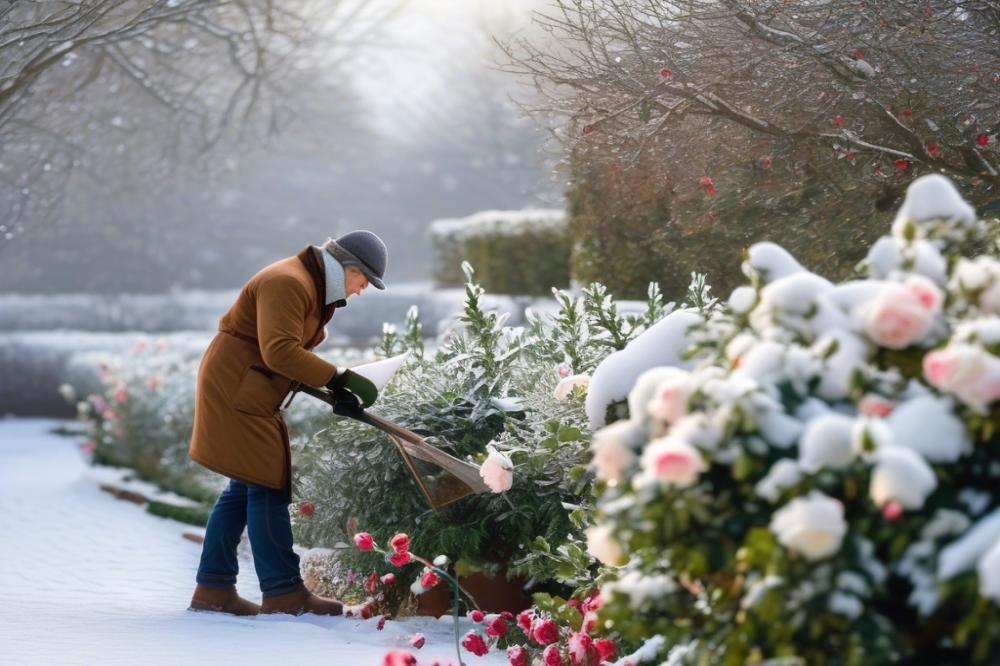Importance of overwintering roses
Caring for roses during winter is essential if you want them to thrive in the seasons to come. These beautiful plants can be quite sensitive to extreme cold and harsh weather. protecting roses from frost is crucial for their survival. Without proper attention, many rose varieties may struggle. Some might not make it through the winter at all.
Challenges Faced by Roses in Winter
Winter brings a host of challenges for gardeners, especially those with cold climate roses. A sudden drop in temperature can cause significant harm. Frost can damage buds, while heavy snow might weigh down branches. Moisture levels in the soil also change drastically, potentially affecting plant health. Many people underestimate these factors, but awareness is key to successful winter care.
Purpose of This Article
This article aims to provide practical garden tips for winter preparation. You’ll learn important techniques like rose pruning and how to use mulch effectively. These practices will provide insulation against the cold. After reading, you will have the knowledge needed to make your roses more resilient. Help your plants survive the winter so they can flourish in spring.
overwintering roses

Overwintering roses means taking specific steps to protect these plants during the cold months. This process is vital for maintaining their health. Without proper care, roses may suffer, leading to poor growth or even death in spring.
Understanding different rose varieties is crucial. Not all roses have the same hardiness levels. Some types thrive in chilly conditions, while others struggle. Knowing which kind you have can make a big difference in winter care. For example, hybrid tea roses often need more protection than hardy shrub roses.
When assessing cold climate roses, consider factors like location and exposure. Certain varieties are better suited to endure harsh winters. Look for plants that have a natural resistance to frost. These choices often lead to better plant health when spring arrives. Proper winter preparation involves selecting the right roses for your area.
Effective winter care requires proper maintenance. rose pruning is an essential step. This practice helps to remove dead or unhealthy stems. Clean cuts encourage new growth in the spring. It also reduces the risk of disease during the winter months.
If you want to protect your flowers from frost, using mulch is highly recommended. Mulch provides insulation against extreme temperatures. A thick layer can help keep the soil temperature consistent. Additionally, it retains moisture, which is beneficial when the temperatures drop.
Further, adding insulation is another excellent strategy. Wrap the base of your roses with burlap or similar materials. This added layer guards against freezing winds and frost damage. Ensure that you do not wrap them too tightly, allowing air circulation. Too much moisture can lead to rot.
Never underestimate the value of solid garden tips. Preparing your roses for winter might seem overwhelming at first. However, with a little planning, you can help your plants survive even the harshest winters. Regular checks throughout the season can also aid in identifying any issues early on.
In conclusion, taking the time to prepare your roses for winter pays off in the vibrant blooms that follow. By understanding their needs, you truly can make a difference. Each step in winter care leads to healthier, more resilient roses when springtime arrives.
Winter Preparation

Timing of Winter Preparation
Taking action at the right time is crucial for successful winter care. Begin your preparations when temperatures start to drop consistently. Generally, this is before the first substantial frost hits. For most regions, late fall is the ideal time to get things ready. Don’t wait until the last minute. Plan ahead to protect your rose varieties effectively.
Recommended Rose Pruning Techniques for Winter
Pruning is an essential part of winter preparation. Cut back your roses to remove dead or weak stems. This technique promotes healthier growth in spring. Aim to trim about one-third of the plant. Make precise cuts at a 45-degree angle above a bud. This encourages new growth while minimizing damage from cold weather. Avoid pruning too late in the season, as it may stimulate new growth that won’t survive the frost.
Signs of Plant Health to Monitor Before Winter
Before winter sets in, keep an eye on the health of your plants. Look for yellow leaves or drooping blooms, which may indicate stress. Check for pests or diseases that can weaken the plants. Strong, healthy plants are more resilient against harsh conditions. Monitor the moisture in the soil as well. Proper hydration will help the roses withstand cold spells better. By observing these signs, you can take necessary actions to improve overall plant health before the chill arrives.
Applying Mulch for Protection
Consider using mulch as an effective insulation layer for your roses. Spread a thick layer around the base of the plants. This serves as protection from frost and helps retain soil moisture. Organic materials like wood chips or straw work best. Cover the roots but avoid piling mulch against the stems. Proper application can make a big difference in how your roses fare during cold spells.
Finding the Right Frost Protection
Installing frost covers can give added protection to cold climate roses. Use horticultural fleece or floating row covers during the coldest nights. These materials help create a buffer against freezing temperatures. Make sure the covers allow air circulation to prevent mold. By taking this extra step, you can support your roses’ ability to survive and thrive in spring.
Garden Tips for Winter Success
Implementing the right garden tips can save your roses in winter. Always clean up fallen leaves and debris around the plants. This helps prevent the spread of disease and pests. Consider applying a slow-release fertilizer before the ground freezes. This step can provide a nutrient boost when growth resumes in early spring. Stay proactive, and your roses will be ready to bloom beautifully when warmer weather arrives.
Winter Care Techniques

Application of Mulch: Benefits and Methods
Mulch plays an essential role in winter care for your roses. Applying a thick layer helps maintain consistent soil temperatures. This protects roots from freezing and thawing cycles that can damage them. Organic mulch, like wood chips or straw, provides additional benefits. It breaks down over time, adding nutrients to the soil while retaining moisture. To apply mulch, spread it around the base of each rose, being careful not to touch the stems. A depth of about three to four inches is ideal. Regularly check the mulch layer, as it may compact or wash away over time. Freshening it up can help sustain plant health throughout winter.
Insulation Strategies for Different Rose Types
Each rose variety may need specific insulation strategies during the colder months. Hybrid teas and floribundas are particularly vulnerable to cold. For these roses, wrapping the base with burlap or using a plant cone can offer extra protection. Climbing roses benefit from being laid down on the ground and covered with soil or mulch. This method shields them from harsh temperatures. If you have cold climate roses, a protective barrier like straw bales can work wonders. Always consider the unique characteristics of your rose varieties when preparing for winter. Knowing how to insulate them can mean the difference between survival and decline.
Frost Protection Methods to Safeguard Blooms and Buds
Frost can be detrimental to emerging blooms and buds in late winter or early spring. Using frost cloths or blankets can keep your roses safe during sudden drops in temperature. Covering your plants at night can limit exposure to freezing conditions. Remember to remove the coverings during the day for sunlight to reach your roses. This practice promotes healthy growth and prevents mold. In addition, watering your roses thoroughly before a frost can increase resilience. Moist soil retains heat better than dry soil, creating a warmer environment for roots. Pay attention to weather forecasts, especially during vulnerable periods. Staying prepared will help protect your blooms from harsh conditions.
Garden Tips for Effective Overwintering

Best Practices for Monitoring and Maintaining Humidity
Humidity plays a vital role in the health of your roses. Proper winter care prevents dehydration and promotes plant wellness. Covering the ground around each rose with mulch can help retain moisture in the soil. Regular checks on the soil’s moisture content are important. Consider using a moisture meter or simply insert your finger into the soil. If it feels dry several inches down, it’s time to water. Also, avoid over-watering, as soggy soil can cause root rot during the cold months.
Common Pests and Diseases to Watch For During Winter
Even in winter, some pests may linger, posing a threat to your plants. Aphids and spider mites sometimes hide under the leaves. While they are less active, they can still cause damage. Inspect your roses regularly for signs of pests. Treat any infestations promptly with appropriate methods, such as insecticidal soap or neem oil. Diseases like black spot may also linger on fallen leaves or nearby plants. Clean around your roses, removing any debris to help protect them from these potential issues.
Creating a Microclimate to Enhance Plant Resilience
Developing a microclimate can greatly benefit cold climate roses. Positioning your roses near walls or fences helps shield them from harsh winds and icy conditions. These structures absorb sunlight during the day and release warmth at night. Plant tall shrubs or other protective plants around your rose varieties, forming a natural barrier. Another effective strategy is to use row covers or frost cloth during extreme weather. These materials provide insulation without trapping too much moisture. Ultimately, small adjustments can lead to significant improvements in your roses’ chances of thriving through winter.
Post-Winter Care and Spring Recovery
Signs that Indicate When to Remove Winter Protection
Checking the ground temperature is essential before you remove frost protection. Once the soil has warmed up consistently, it’s time to act. Look for new growth on the stems; this is a promising sign of life. Conversely, if frost threatens again, keep the insulation in place a bit longer. Shrubs should start showing buds as temperatures rise. Rose varieties that thrive in cold climates may need a little extra attention during these early days of spring. Removing protection too early can stress the plants.
Best Practices for Spring Pruning and Care
Begin your rose pruning as soon as the danger of hard frost has passed. Cut back any dead or damaged stems to promote healthy growth. Focus on removing branches that cross each other or are too densely packed. This opens up the plant, improving air circulation and sunlight exposure. Using sharp, clean tools is vital for making clean cuts. Remember that different rose varieties may have unique pruning needs. After making the cuts, keep the mulch in place for additional warmth at the roots.
Encouraging Vigorous Growth After Winter
Promoting plant health post-winter requires proper fertilization. Use a balanced fertilizer to jumpstart their growth. Follow up with good watering practices, especially if rainfall is scarce. Well-drained soil helps roots develop strong and healthy. Adding organic compost can also improve soil quality. Use these garden tips to foster an environment where your roses can thrive. Consider layering mulch again to maintain moisture levels and suppress weeds. Careful observation of your garden will guide you along the way to ensuring robust blooms.
Final Thoughts on Overwintering Roses
We’ve outlined the essential steps to protect your beautiful roses from the harsh winter months. First, you must prepare them before the frost sets in. This involves proper rose pruning and ensuring that they are well fertilized and watered. Adding a layer of mulch can also provide critical insulation for the roots. Doing these tasks early will set a solid foundation for your roses’ health.
Embracing winter care practices is not just beneficial; it can result in a garden that flourishes come spring. The effort you put in during these chilly months pays off when you see vibrant blooms. Roses are resilient, but they need your support against frosty conditions. Don’t hesitate to show your plants the love they deserve.
Protecting your roses from winter’s cold requires attention and action. By following these tips, you can keep your plants safe. You’ll be rewarded in the spring with healthy and beautiful flowers, reminding you of your hard work. Your roses deserve the best, so take the necessary steps this winter to support their growth. In the end, a little preparation goes a long way in ensuring a plentiful bloom season.



